Last week the weather was rather unpredictable. Quite a lot of wind during the week; sometimes too much to paddle, but it was expected that Sunday the wind would increase to approx. 5-6bft with its limit in the evening at 7bft.
So, time for paddling the 16X in seaconditions is what I thought.
I found Roel and Maarten (both paddling an Atlantic) willing to accompany me to the Voordelta in the south of Holland.
Starting at 11h the wind blows as predicted at 3bft but instead of increasing gradually, the wind just decreased to almost zero during the afternoon.
No problem as I was in good company: we had a very pleasant tour.
Starting from the south end of the Brouwersdam we headed West first to visited a sandplate for lunch.
The waves were not very intimidating (small and lively) as you can imagine. We paddled against the waves and the 16X had no problems in steering or whatever. There was no need to use the rudder as the kayak runs just straight and small corrections were done automatically with the paddle. When using the rudder (I am testing you know:wink:) I found nothing new other than that I am still not used to the delayed response of a steering command to the rudder. This is especially true when paddling with the knees under the deck because the feet can not reach maximum left- or right position of the rudder. When paddling with the knees up in racing position, the rudder is much easier to operate and because it is in this position possible to give the rudder a full left or -right, the working is acceptable to me.
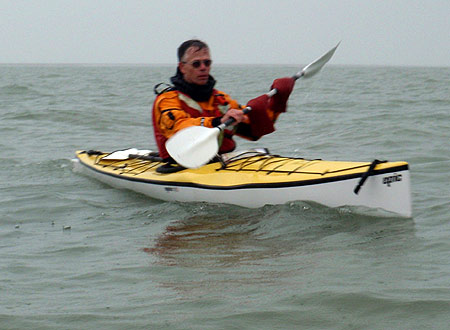
Having reached the sandplate the waves were not of any importance and after a cosy lunch we went to the area where more waves are available. This is a deeper unprotected channel where the see has easy access and you can find normally longer waves there. I am especially looking for bigger waves the test the 16X in: running with the waves for rudder-functioning while running or surfing. You can expect that the rudder, situated at the stern of the kayak, will be immersed completely in the pushing wave may be resulting in more alert response. (this are my thoughts and I would like to find out still !)
Running on short waves is not very easy as I concluded earlier, but I think that there is a chance that this kayak functions better in bigger waves.
Today there were longer waves at the spot as I expected, probably still the result of the strong wind during the last few days. But they were not big enough (approx. 50-60cm) to get the kayak surfing easily. When surfing I had the dilemma that I would like to have my knees under the deck for boat-control in the waves but than I could not give full rudder resulting in broaching.
At the spot above a shallow e crossed some breaking waves together to try to reproduce the film by Epic in which they compare the 18X with a conventional seakayak in braking waves. Purpose of this film is to show that an Epic kayak rocks less than the conventional kayak. At our relaxed pace we could not see a big difference between the 16X and both Atlantics. Yes only slightly. I can imagine however that paddling at full power against waves will show the difference as the sharp-bow of the 16X will just pierce the wave.
I think I will have to find similar waves as the film: just outside of the surfzone with some whitecaps on top.
After this exercise we changed course till we had the waves straight from behind intending to go back to the coast. At first we could surf occasionally but the more we reached the coast the lower the waves. As the waves were rather lively it was interesting to experience how the 16X behaved herself.
Due to her short length she is rather maneuverable and this made that the pushing waves made her respond to every wave. I had to concentrate thus on keeping course. As the kayak has only a rudder this is the only means to keep her running straight. As described above the easiest with the knees in up position. It kept me rather busy. To compare with any maneuverable kayak: if such a kayak has an variable skeg you drop it under such conditions to have a more relaxed ride.
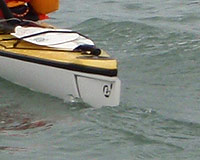
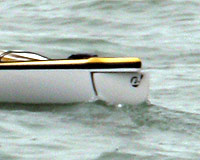
While paddling my mates noticed that the rudder quite often is above the water. This can explain why you have to wait sometimes before something happens: the rudder has to be immersed again.
On the other hand they also noticed that only the small fin, which protrudes at the underside of the rudder, is the real working part of the rudder as the rest only touches the water.
At this moment the weight of the paddlers comes into view: being heavier or having the kayak loaded, will certainly make the kayak much more responsive to the rudder. It could well be that 16X-owners, reading my experiences, don't recognize my experiences with the rudder. It would be interesting to know how much heavier they are than my 72kg. Maybe in my case the effective part of the rudder in the water is too small .
An improvement might be the new rudder-construction: on pictures the fin (retractable now) seems a bit bigger.
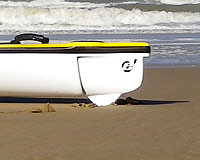
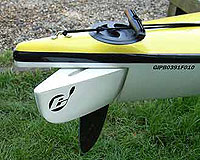
left: old rudder # right: new rudder
Another thought came into our minds while trying to understand this kayak: It could well be that it was not a very good idea to develop a shorter kayak based on the successful 18X. The capacities of the 18X (I hope to paddle a 18X as well to be able to make a proper comparison) are based on its much greater length making her less sensitive to being pushed to another course by waves and making her less nervous. In that case you don't need the rudder other than to compensated for slight weather- or leecocking. As this long kayak will run straight, the only thing to do is to put the rudder at a constant angle as the circumstances require for keeping the required course.
I would also like to mention that Maarten looked at Roels Atlantic while paddling next to the 16X to see a possible difference in rocking between the two kayaks. Also now, while running with the waves, the difference was only very small: the 16X only rocking slightly less than an Atlantic.
I just wonder of this rocking is much more a positive issue with the 18X (may be the film was taken with the 18X ?) which is narrower and about 60cm longer.
please take a look at the Epic film underneath:
Finally some details
Starting at the beach I tried to get into the cockpit while floating already: just to prevent the fin ploughing through the sand. Thanks to the big cockpit this was very easy: sit down , pull legs inside and paddle away afterwards closing the sprayskirt.
The elastics on the foredeck are positioned so close together that it is impossible to tuck an A3-card-map underneath in landscape-position.
The stability of this kayak is perfect as mentioned before on other occasions.
To be continued.
